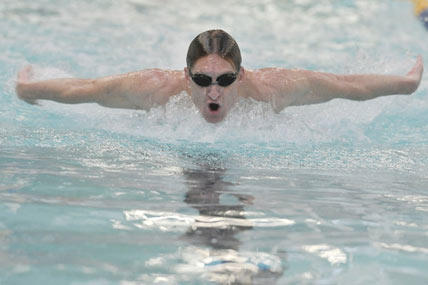Approaching the wall in the qualifying heat for the U.S. Swim Team in Bismarck, N.D., in June, Brad Snyder pushed himself harder than ever before, adroitly counting each stroke as he prepared for the turn that would push him into a qualifying position.
He knew he couldn't gauge how hard to drive in the final stretch based on the closing speed of his nearest competitor because he couldn't see who was there. In fact, he couldn't see the lane markers, the bottom of the pool, the time clock, or the wall he was attempting to reach in record pace.
That's because Navy Lt. Brad Snyder is blind.
On a 2011 deployment to Afghanistan as an Explosive Ordinance Disposal (EOD) technician, he was attempting to assist in evacuating two IED victims when he stepped on a pressure switch not unlike the time pad at the end of a swimming lane. But when this deadly circuit connected, it didn't stop a race clock; it detonated a 40-pound explosive just four feet in front of him.
Though Brad miraculously walked away from the blast site onto a helicopter waiting to evacuate the injured to a safe location, the white-hot blast was one of the last things he would ever fully see.
Even without his eyes to guide him, Brad maintained a resilient focus in the following months. Lying in a hospital bed with his eyes sewn shut and much of his face covered with third-degree burns, he mentally made the choice to find a way to move forward. "I was not going to let my injuries get me down. Compared to other patients who were on my floor, I had nothing to whine about," he said recently in an interview.
He chose to move forward by heading to the water as a means to gain back some of the sense of achievement he once felt as a naval operator, and taking solace in the familiar team camaraderie he once found in the Naval Academy pool, where he served as a team captain his senior year. Soon, he was swimming times on par with national competitors. A bid for the U.S. Paralympic Swim Team was a natural progression.
In this year's June trials for the 400-meter freestyle, Brad swam a full 54 seconds faster than his previous best, securing his place on the Paralympic team. With the assistance of the nonprofit COMMIT, an organization dedicated to one-on-one assistance for wounded warriors in transition, Brad found work with a software company based in Baltimore and has been able to focus on working toward his Paralympic aspirations ever since.
When various national events were organized to cheer Brad toward the finish line, he requested that the money raised through "Team Brad" T-shirt sales be donated back to the COMMIT Foundation in order to support other injured servicemembers.
In London late this month, Brad will keep a grueling schedule, swimming in Freestyle, Backstroke, Breaststroke, and Butterfly events daily from Aug. 31 through Sept. 3.
September 7, the day he swims the 400-meter freestyle, also happens to be the one-year anniversary of the IED explosion that took his eyes. The irony of the date isn't lost on Brad, and when asked whether he'd choose the dangerous Navy EOD community again, he didn't hesitate to respond.
"I'd give my eyes 100 times again to have the chance to do what I have done and what I can still do. There are no regrets for any decision I have made," he said.
On the international Paralympic stage, Brad will swim in a cap with the American flag on one side and the familiar Naval Academy "N" on the other. Swimming now with two prosthetic eyes, he hopes to both represent and inspire other injured veterans. "All sorts of people have contacted me to say, 'You really inspired us just by the fact that you've moved forward,' " he said. "I want them to see that despite this type of wound, you can go out and excel."






























